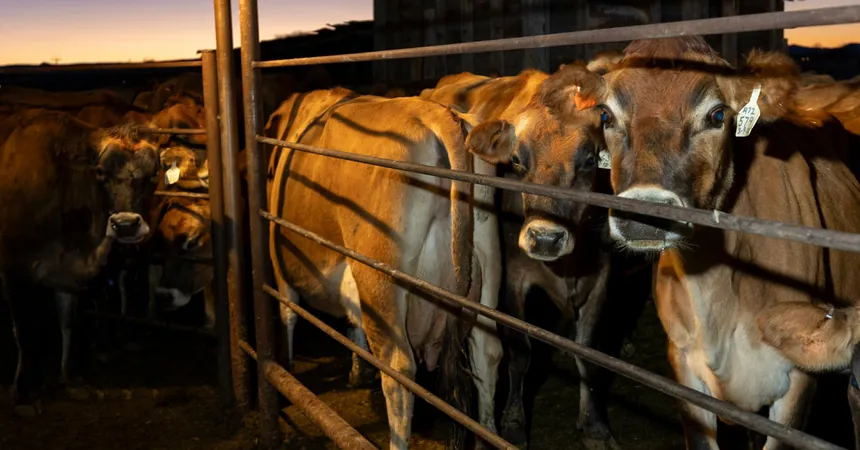
The Bird Flu Crisis Escalates: Experts Warn of Potential Pandemic!
2025-01-27
Author: Yan
The Bird Flu Outbreak
The bird flu outbreak has taken an alarming turn over the past year, showing signs of persistence rather than a swift decline. Initially perceived as a limited threat to a handful of dairy herds, the H5N1 virus has now spread to over 900 herds and dozens of humans, resulting in at least one death. This troubling trend has prompted scientists to consider the potential for a human pandemic, a scenario that once seemed remote but now appears increasingly plausible.
Public Health Concerns
Experts voice serious concerns regarding the public health response to this outbreak. Critiques highlight insufficient guidelines, delayed testing, and the slow release of critical data—issues eerily reminiscent of the initial stages of the Covid-19 pandemic. For instance, recent reports have surfaced indicating that dairy herds in Idaho displayed mild symptoms for the second time after being infected earlier in the year, raising questions about the accuracy and timeliness of reporting by the Department of Agriculture.
Long-term Presence of H5N1 Virus
The second wave of infections, while showing milder symptoms, suggests a disturbing trend: the H5N1 virus might find a way to circulate among cattle indefinitely. This long-term presence of the virus could hinder detection efforts, as noted by evolutionary biologist Louise Moncla from the University of Pennsylvania. She likened the risk to having an undetectable infection within dairy herds, which could evolve into a more potent strain.
Official Statements and Recommendations
While some health officials maintain that H5N1 currently poses a low risk to the general public, they warn that the situation could change rapidly. Dr. Nirav Shah from the CDC cautioned, "This is a dangerous virus," highlighting the need for vigilance and public awareness. Protective measures are advised: avoid contact with sick or dead birds, get tested for flu-like symptoms, and refrain from consuming raw milk or undercooked meat.
Vaccination and Public Safety Concerns
The federal government's stockpile includes millions of bird flu vaccine doses, but these may not align with any new, mutated strains of the virus. In the event of a major outbreak, producing adequate vaccines to meet public demand may present significant challenges.
Historical Context of H5N1
H5N1 is not new; it has historically emerged in specific regions and animal populations before threatening humans. The current outbreak, which started as early as January 2022, has already impacted over 136 million birds and has led to price spikes in eggs and poultry. Alarmingly, the virus has also affected various mammals, including wild and domestic cats, raccoons, bears, and sea lions.
Increasing Human Infections
Experts believe that rising human infections raise red flags for future health crises. 67 Americans were infected in 2024 alone, compared to just one case in 2022. The nature of these infections is concerning—some individuals displayed severe symptoms, and mutations within the virus during their infections could enhance its ability to spread among humans.
Mutations and Emerging Threats
Research has indicated troubling mutations that may facilitate the virus's ability to infect human cells. Recent cases involving a Canadian teenager and a Louisiana resident demonstrate this evolving threat. Both fell seriously ill after contracting a new strain of H5N1 that has now become widespread among birds.
Food Safety and Contamination Concerns
Further complicating matters, the spread of H5N1 through food sources and animal feeds is raising alarms. Cases of domestic cats dying after ingesting raw pet food contaminated with the virus prompted recalls and new federal guidelines on pet food safety. Although cooking and pasteurization can kill the virus, experts warn that there is no foolproof method to guarantee food safety in production.
Federal Measures and Challenges
Despite ongoing concerns, federal measures to combat the outbreak have been criticized as ineffectual and slow. Testing for H5N1 vaccines for cattle lagged, leaving companies uncertain about their next steps. Moreover, the lack of clear data on herd reinfections has hampered efforts to track the virus's evolution and spread effectively.
Conclusion: A Call for Vigilance
As experts continue to monitor this situation closely, the warning signs are undeniable. The bird flu outbreak could signal the start of a serious health crisis, challenging public health systems worldwide. Alertness and proactive responses are crucial to mitigating the risk of a full-blown pandemic. Stay informed, stay safe, and let us hope that swift action can alter this concerning trajectory!



 Brasil (PT)
Brasil (PT)
 Canada (EN)
Canada (EN)
 Chile (ES)
Chile (ES)
 Česko (CS)
Česko (CS)
 대한민국 (KO)
대한민국 (KO)
 España (ES)
España (ES)
 France (FR)
France (FR)
 Hong Kong (EN)
Hong Kong (EN)
 Italia (IT)
Italia (IT)
 日本 (JA)
日本 (JA)
 Magyarország (HU)
Magyarország (HU)
 Norge (NO)
Norge (NO)
 Polska (PL)
Polska (PL)
 Schweiz (DE)
Schweiz (DE)
 Singapore (EN)
Singapore (EN)
 Sverige (SV)
Sverige (SV)
 Suomi (FI)
Suomi (FI)
 Türkiye (TR)
Türkiye (TR)